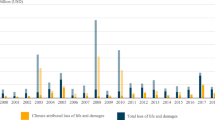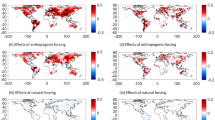Abstract
There is a tremendous desire to attribute causes to weather and climate events that is often challenging from a physical standpoint. Headlines attributing an event solely to either human-induced climate change or natural variability can be misleading when both are invariably in play. The conventional attribution framework struggles with dynamically driven extremes because of the small signal-to-noise ratios and often uncertain nature of the forced changes. Here, we suggest that a different framing is desirable, which asks why such extremes unfold the way they do. Specifically, we suggest that it is more useful to regard the extreme circulation regime or weather event as being largely unaffected by climate change, and question whether known changes in the climate system's thermodynamic state affected the impact of the particular event. Some examples briefly illustrated include 'snowmaggedon' in February 2010, superstorm Sandy in October 2012 and supertyphoon Haiyan in November 2013, and, in more detail, the Boulder floods of September 2013, all of which were influenced by high sea surface temperatures that had a discernible human component.
This is a preview of subscription content, access via your institution
Access options
Subscribe to this journal
Receive 12 print issues and online access
$209.00 per year
only $17.42 per issue
Buy this article
- Purchase on Springer Link
- Instant access to full article PDF
Prices may be subject to local taxes which are calculated during checkout





Similar content being viewed by others
References
Johnstone, J. A. & Mantua, N. J. Atmospheric controls on northeast Pacific temperature variability and change, 1900–2012. Proc. Natl Acad. Sci. USA 111, 14360–14365 (2014).
Shepherd, T. G. Atmospheric circulation as a source of uncertainty in climate change projections. Nature Geosci. 7, 703–708 (2014).
IPCC Climate Change 2013: The Physical Science Basis (eds Stocker, T. F. et al.) (Cambridge Univ. Press, 2013).
Herring, S. C., Hoerling, M. P., Peterson T. C. & Stott, P. A. (eds) Explaining extreme events of 2013 from a climate perspective. Bull. Am. Meteorol. Soc. 95, S1–S96 (2014).
Trenberth, K. E. Attribution of climate variations and trends to human influences and natural variability. WIREs Clim. Change 2, 925–930 (2011).
Trenberth, K. E. Framing the way to relate climate extremes to climate change. Climatic Change 115, 283–290 (2012).
Wallace, J. M. Weather- and climate-related extreme events: Teachable moments. Eos 93, 120–121 (2012).
Stott, P. et al. in Climate Science Serving Society (eds Asrar, G. R. & Hurrell, J. W.) 307–337 (Springer, 2013).
Deser, C., Phillips, A., Bourdette, V. & Teng, H. Y. Uncertainty in climate change projections: The role of internal variability. Clim. Dynam. 38, 527–546 (2012).
Deser, C., Phillips, A. S., Alexander, M. A. & Smoliak, B. V. Projecting North American climate over the next 50 years: Uncertainty due to internal variability. J. Clim. 27, 2271–2296 (2014).
Trenberth, K. E. Changes in precipitation with climate change. Clim. Res. 47, 123–138 (2011).
Trenberth, K. E. Atmospheric moisture residence times and cycling: Implications for rainfall rates with climate change. Climatic Change 39, 667–694 (1998).
Trenberth, K. E., Dai, A., Rasmussen, R. M. & Parsons, D. B. The changing character of precipitation. Bull. Am. Meteorol. Soc. 84, 1205–1217 (2003).
Trenberth, K. E., Fasullo, J. T., Branstator, G. & Phillips, A. S. Seasonal aspects of the recent pause in surface warming. Nature Clim. Change 4, 911–916 (2014).
Branstator, G. & Teng, H. Is AMOC more predictable than North Atlantic heat content? J. Clim. 27, 3537–3550 (2014).
Seneviratne, S. I. et al. Investigating soil moisture–climate interactions in a changing climate: A review. Earth Sci. Rev. 99, 125–161 (2010).
Trenberth, K. E. et al. Global warming and changes in drought. Nature Clim. Change 4, 17–22 (2014).
Lyons, L., Discovery or fluke: Statistics in particle physics. Phys. Today 65, 45–51 (2012).
Trenberth, K. E., Fasullo, J. & Smith, L. Trends and variability in column-integrated atmospheric water vapor. Clim. Dynam. 24, 741–758 (2005).
February 2010: Snowmageddon, Blizzard of 2010 WINTER: Unprecedented Snowfall Impacts Region (PRESTO, 2010); http://go.nature.com/IBxDJD.
Blake, E. S., Kimberlain, T. B., Berg, R. J., Cangialosi, J. P. & Beven, J. L. II Tropical Cyclone Report: Hurricane Sandy Report no. AL182012 (National Hurricane Center, 2013); http://go.nature.com/sjCrrH
Hurricane/Post-Tropical Cyclone Sandy, October 22–29, 2012 Service Assessment (NOAA, 2013); http://go.nature.com/BqlTxe
Magnusson, L. et al. Evaluation of medium-range forecasts for hurricane Sandy. Mon. Weather Rev. 142, 1962–1981 (2014).
Evans, A. D. & Falvey, R. J. Annual Tropical Cyclone Report 2013 (Naval Maritime Forecast Center/ Joint Typhoon Warning Center, 2013); http://go.nature.com/V9JpKu.
Lin, I-I., Pun, I-F. & Lien, C-C. 'Category-6' Supertyphoon Haiyan in global warming hiatus: Contribution from subsurface ocean warming. Geophys. Res. Lett. 41, 8547–8553 (2014).
Trenberth, K. E. & Fasullo, J. T. An apparent hiatus in global warming? Earth's Future 1, 19–32 (2013).
Trenberth, K. E., Fasullo, J. T. & Balmaseda, M. A. Earth's energy imbalance. J. Clim. 27, 3129–3144 (2014).
Hoerling, M. et al. Northeast Colorado extreme rains interpreted in a climate change context. Bull. Am. Meteorol. Soc. 95 (Special issue), S15–S18 (2014).
Brennan, C. Boulder researcher: 2013's flood-triggering rains not caused by climate change. Daily Camera (29 September 2014); http://go.nature.com/2y9zuO.
Pasch, R. J. & Zelinsky, D. A. Hurricane Manuel EP132013 (National Hurricane Center, 2014); http://go.nature.com/8ORDI9.
Beven, J. L. II Hurricane Ingrid AL102013 (National Hurricane Center, 2014); http://go.nature.com/QzAQuL.
Dole, R. et al. Was there a basis for anticipating the 2010 Russian heat wave? Geophys. Res. Lett. 38, L06702 (2011).
Rahmstorf, S. & Coumou, D. Increase of extreme events in a warming world, Proc. Natl Acad. Sci. USA 108, 17905–17909 (2011).
Otto, F. E. L., Massey, N., van Oldenborgh, G. J., Jones, R. G. & Allen, M. R. Reconciling two approaches to attribution of the 2010 Russian heat wave. Geophys. Res. Lett. 39, L04702 (2012).
Trenberth, K. E. & Fasullo, J. T. Climate extremes and climate change: The Russian heat wave and other climate extremes of 2010. J. Geophys. Res. 117, D17103 (2012).
Seager, R. et al. Causes and Predictability of the 2011–14 California Drought (NOAA, 2014); http://go.nature.com/IBpoCA.
Diffenbaugh, N. S., Swain D. L. & Touma, D. Anthropogenic warming has increased drought risk in California. Proc. Natl Acad. Sci USA 112, 3931–3936 (2015).
Acknowledgements
The National Center for Atmospheric Research is sponsored by the National Science Foundation. This work is supported by DOE award DE-SC0012711. T.G.S. acknowledges the support provided through the Grantham Chair in Climate Science at the University of Reading.
Author information
Authors and Affiliations
Contributions
K.E.T. led the writing of the paper and conceived of the paper and figures. J.T.F analysed some data and contributed to two figures. All authors contributed to writing the manuscript.
Corresponding author
Ethics declarations
Competing interests
The authors declare no competing financial interests.
Rights and permissions
About this article
Cite this article
Trenberth, K., Fasullo, J. & Shepherd, T. Attribution of climate extreme events. Nature Clim Change 5, 725–730 (2015). https://doi.org/10.1038/nclimate2657
Received:
Accepted:
Published:
Issue Date:
DOI: https://doi.org/10.1038/nclimate2657
This article is cited by
-
Exacerbated summer European warming not captured by climate models neglecting long-term aerosol changes
Communications Earth & Environment (2024)
-
Research progresses and prospects of multi-sphere compound extremes from the Earth System perspective
Science China Earth Sciences (2024)
-
Exploring relationships between drought characteristics and environmental flow conditions in Indian catchments
Environmental Earth Sciences (2024)
-
Variations of salinity during reproduction and development affect ontogenetic trajectories in a coastal amphibian
Environmental Science and Pollution Research (2024)
-
Response patterns of simulated corn yield and soil nitrous oxide emission to precipitation change
Ecological Processes (2023)



